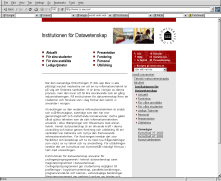The web structure of the department
This information is directed to employees who intend to create web pages according to the model of the department.

Introduction
To create a web structure which is easy to maintain, build each page using so-called Server Side Includes, SSI. Observe that a number of variables are set to control the way the appearance and then a pair of standard pages are included.
A short introduction to SSI
Apache's introduction to SSI is found here
The core of SSI is a language which is embedded in HTML comments;
the statements are of the general form
<!--#CMD EXPR="VALUE"-->
Setting variables
<!--#set var="NAME" value="VALUE" -->
The above example sets the variable NAME to the value VALUE.
Including files
<!--#include virtual="FILNAME" -->
This includes an external HTML file at the location of the
directive.
The name is virtual (as is seen in web space); in other words
/include/head.html
corresponds to the which is found on the web under
http://www.cs.umu.se/include/head.html.
Executing cgi commands
<!--#exec cgi="FILNAME" -->
Conditional statements
<!--#if expr="EXPRESSION" -->
<!--#elseif -->
<!--#else -->
creates a conditional statement whose execution is controlled by EXPRESSION.
See Apache's documentation mod_include
for more information on valid expressions and built-in variables.
Variables
These are the variables which are used in standard patterns. All
file names in the table indicate the base name of the file
and are relative to /include.
| Variable | File | Description |
|---|---|---|
| description | head.html | Sets description in the META
field. This description is used from time to time in
search engines, etc., as a summary of the page.
|
| foot.html (footer.html) | Gives the e-mail address of the person responsible for the web page. | |
| extra_css | head.html | If it is desired to use CSS (Cascading Style Sheets), it is
necessary to use the style patterns in
<head>. Set this variable to the name of the file
which contains the patterns and should be included.
Remember that the search path is relative to
/include. |
| graymenu_aktuell graymenu_amanuens graymenu_education graymenu_information graymenu_intern graymenu_jamstalldhet graymenu_openpos graymenu_organization graymenu_research graymenu_staff |
foot.html (graymenu/intern.html graymenu/organization.html) |
The variables indicate which submenus in the gray (higher)
menu should be expanded. If the page is situated under
https//www.cs.umu.se/intern/, if
graymenu_intern is set to some value that menu will be
expanded.
|
| keywords | head.html | Sets the keywords in the META field. This
information is used, for example, by search engines
to categorize the the page. |
| namn | foot.html (footer.html) | The name of the person whose is responsible for the page. |
| pagetitle | head.html | The title of the page as it appears in the document. |
| showcsheader | head.html | Indicates whether the Datavetenskap header and image with logo should be displayed. Usually used only on the first page. |
| showbullets | head.html | Indicates whether subject bullets should be displayed. Used normally only on the first page. |
| title | head.html | Indicates the title of the page, that title which is shown in the web browser as the title. |
Multi-lingual pages
For the document to exist in several languages, there are a number of issues to consider.
- File naming To have the web browser choose the language
of presentation automatically (according to configuration
in the browser), files with suffixes are used; for
example,
index.html.enfor English orindex.html.svfor Swedish. For a more complete list of languages and suffixes, see the language configurations of the browser. - Inclusion of templates Standard templates exist for Swedish and English versions. By default the template chosen in accordance with the language configuration of the browser.
- In English To enable the "In English" function in the
the navigation menu to the right, it is necessary to take a few steps.
First, the files
head_eng.html,foot_eng.htmlin the English-language pages, andhead_swe.htmlandfoot_swe.htmlinstead of the usualhead.htmlandfoot.html. This is necessary to have a consistent language over the whole page regardless of the browser settings. (Make sure that they are symbolic links and that furthermore.html.enand.html.svexist, so that automatic language selection works.) Second, create two extra symbolic links from the English page variant (e.g.,foo.html.en) to one with_engor_sweaffixed to the base name, as appropriate (e.g.,foo_eng.html).
Creating a simple web page
The example below can be seen as a simple pattern for creating normal pages. That which must be added is the expansion of the correct submenus, dependent upon where in the structure the file is located.
The following is skeleton code from a page with the title "Foo:", subtitle "Bar", and "Nils Holgersson <nisse>" responsible for the page.
|
<!--#set var="title" value="Institutionen för datavetenskap - Foo" --> <!--#set var="pagetitle" value="Bar" --> <!--#set var="email" value="nisse@cs.umu.se" --> <!--#set var="namn" value="Nils Holgersson" --> <!--#include virtual="/include/head.html" --> <p>A foo is a bar</p> <!--#include virtual="/include/foot.html" --> |